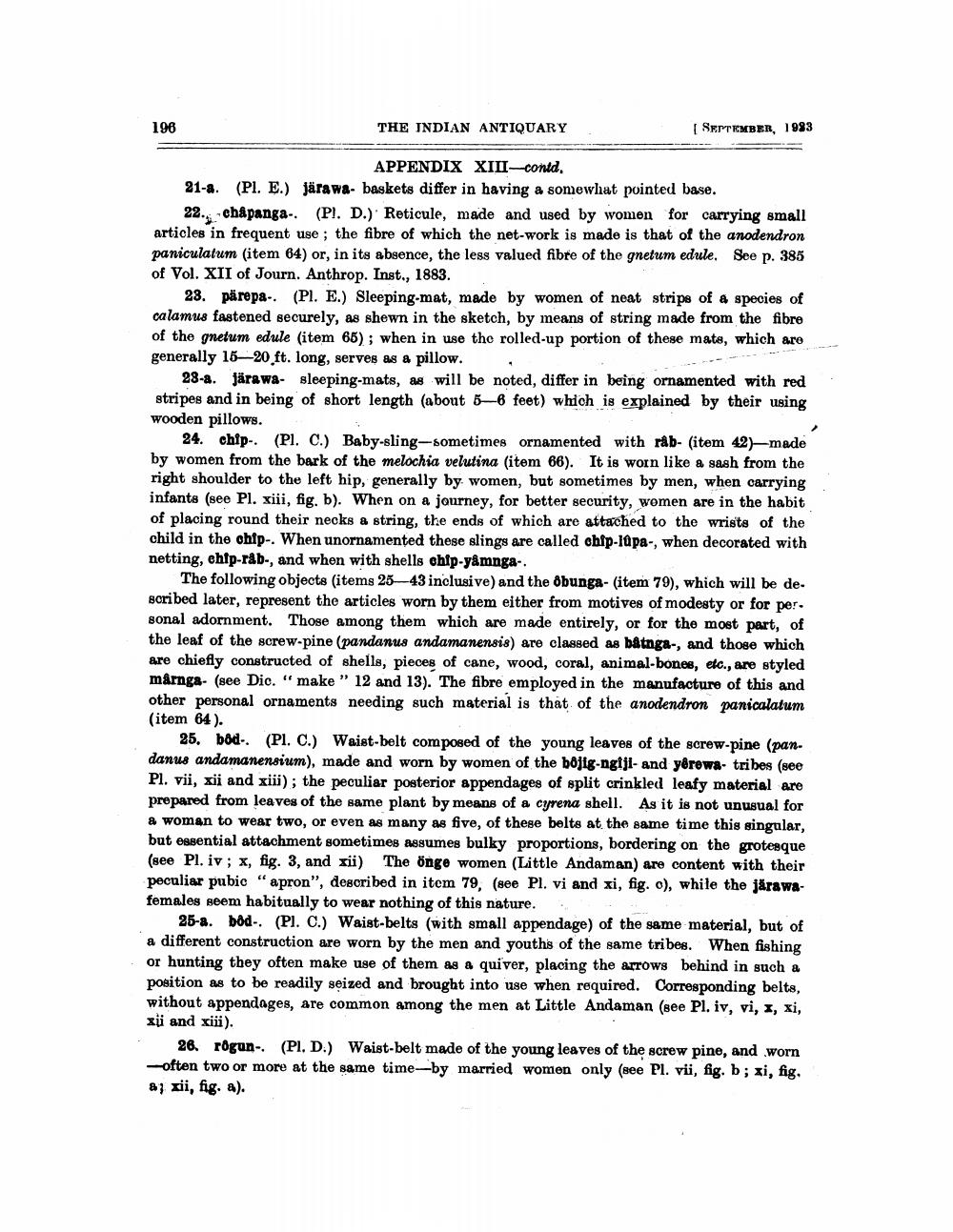________________
THE INDIAN ANTIQUARY
APPENDIX XIII-contd.
21-a. (Pl. E.) järawa- baskets differ in having a somewhat pointed base.
22. chapanga. (Pl. D.) Reticule, made and used by women for carrying small articles in frequent use; the fibre of which the net-work is made is that of the anodendron paniculatum (item 64) or, in its absence, the less valued fibre of the gnetum edule. See p. 385 of Vol. XII of Journ. Anthrop. Inst., 1883.
196
[ SEPTEMBER, 1983
23. pärepa-. (Pl. E.) Sleeping-mat, made by women of neat strips of a species of calamus fastened securely, as shewn in the sketch, by means of string made from the fibre of the gnetum edule (item 65); when in use the rolled-up portion of these mats, which are generally 15-20 ft. long, serves as a pillow.
28-a. järawa- sleeping-mats, as will be noted, differ in being ornamented with red stripes and in being of short length (about 5-6 feet) which is explained by their using wooden pillows.
24. chip-. (Pl. C.) Baby-sling-sometimes ornamented with råb- (item 42)-made by women from the bark of the melochia velutina (item 66). It is worn like a sash from the right shoulder to the left hip, generally by women, but sometimes by men, when carrying infants (see Pl. xiii, fig. b). When on a journey, for better security, women are in the habit of placing round their necks a string, the ends of which are attached to the wrists of the child in the chip-. When unornamented these slings are called chip-lupa-, when decorated with netting, chip-råb-, and when with shells chip-yâmnga-.
The following objects (items 25-43 inclusive) and the ôbunga- (item 79), which will be described later, represent the articles worn by them either from motives of modesty or for personal adornment. Those among them which are made entirely, or for the most part, of the leaf of the screw-pine (pandanus andamanensis) are classed as batnga-, and those which are chiefly constructed of shells, pieces of cane, wood, coral, animal-bones, etc., are styled mârnga (see Dic. "make" 12 and 13). The fibre employed in the manufacture of this and other personal ornaments needing such material is that of the anodendron panicalatum (item 64).
25. bôd. (Pl. C.) Waist-belt composed of the young leaves of the screw-pine (pandanus andamanensium), made and worn by women of the bojig-ngiji- and yêrewa- tribes (see Pl. vii, xii and xiii); the peculiar posterior appendages of split crinkled leafy material are prepared from leaves of the same plant by means of a cyrena shell. As it is not unusual for a woman to wear two, or even as many as five, of these belts at the same time this singular, but essential attachment sometimes assumes bulky proportions, bordering on the grotesque (see Pl. iv; x, fig. 3, and xii) The önge women (Little Andaman) are content with their peculiar pubic "apron", described in item 79, (see Pl. vi and xi, fig. o), while the järawafemales seem habitually to wear nothing of this nature.
25-a. bôd. (Pl. C.) Waist-belts (with small appendage) of the same material, but of a different construction are worn by the men and youths of the same tribes. When fishing or hunting they often make use of them as a quiver, placing the arrows behind in such a position as to be readily seized and brought into use when required. Corresponding belts, without appendages, are common among the men at Little Andaman (see Pl. iv, vi, x, xi, xii and xiii).
26. rogun-. (Pl. D.) Waist-belt made of the young leaves of the screw pine, and worn -often two or more at the same time-by married women only (see Pl. vii, fig. b; xi, fig. aj xii, fig. a).




